| |||||
| Decades: | |||||
|---|---|---|---|---|---|
| See also: | History of Zaire | ||||

The following lists events that happened during 1986 in Zaire .
| |||||
| Decades: | |||||
|---|---|---|---|---|---|
| See also: | History of Zaire | ||||

The following lists events that happened during 1986 in Zaire .
| Date | event |
|---|---|
| Zaire suffered from a measles epidemic in 1986 that continued into 1987. [1] |
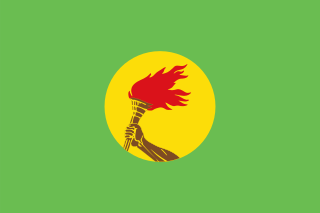
Zaire, officially the Republic of Zaire, was the name of the Democratic Republic of the Congo from 1971 to 1997. Located in Central Africa, it was, by area, the third-largest country in Africa after Sudan and Algeria, and the 11th-largest country in the world from 1965 to 1997. With a population of over 23 million, Zaire was the most populous Francophone country in Africa. Zaire played a central role during the Cold War.

Mobutu Sese Seko Kuku Ngbendu wa za Banga, commonly known as Mobutu Sese Seko or simply just Mobutu and also by his initials MSS, was a Congolese politician and military officer who was the 1st and only President of Zaire from 1971 to 1997. Previously, Mobutu served as the 2nd President of the Democratic Republic of the Congo from 1965 to 1971. He also served as the 5th Chairman of the Organisation of African Unity from 1967 to 1968. During the Congo Crisis, Mobutu, serving as Chief of Staff of the Army and supported by Belgium and the United States, deposed the democratically elected government of left-wing nationalist Patrice Lumumba in 1960. Mobutu installed a government that arranged for Lumumba's execution in 1961, and continued to lead the country's armed forces until he took power directly in a second coup in 1965.

Zaire is one of the 18 provinces of Angola. It occupies 40,130 square kilometres (15,490 sq mi) in the north west of the country and had a population of 594,428 inhabitants in 2014. It is bordered on the west by the Atlantic Ocean, on the north by the Democratic Republic of Congo, on the east by the Uíge Province, and on the south by the Bengo Province.

Léon Kengo wa Dondo is a Congolese politician who served as the "first state commissioner" several times under Mobutu Sese Seko in Zaïre. He was one of the most powerful figures in the regime and was a strong advocate of economic globalization and free-market economics. He served as President of the Senate of the Democratic Republic of the Congo from 2007 to 2019.

Kniphofia is a genus of perennial flowering plants in the family Asphodelaceae, first described as a genus in 1794. All species of Kniphofia are native to Africa. Common names include tritoma, red hot poker, torch lily and poker plant.

The First Congo War, also nicknamed Africa's First World War, was a civil war and international military conflict which lasted from 24 October 1996 to 16 May 1997 and took place mostly in Zaire, with major spillovers into Sudan and Uganda. The conflict culminated in a foreign invasion that replaced Zairean president Mobutu Sese Seko with the rebel leader Laurent-Désiré Kabila. Kabila's unstable government subsequently came into conflict with his allies, setting the stage for the Second Congo War in 1998–2003.

Robert James Fischer was an American chess grandmaster and the eleventh World Chess Champion. A chess prodigy, he won his first of a record eight US Championships at the age of 14. In 1964, he won with an 11–0 score, the only perfect score in the history of the tournament. Qualifying for the 1972 World Championship, Fischer swept matches with Mark Taimanov and Bent Larsen by 6–0 scores. After winning another qualifying match against Tigran Petrosian, Fischer won the title match against Boris Spassky of the USSR, in Reykjavík, Iceland. Publicized as a Cold War confrontation between the US and USSR, the match attracted more worldwide interest than any chess championship before or since.
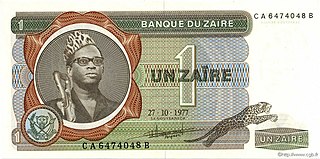
The zaire was the unit of currency of the Democratic Republic of the Congo and then of the Republic of Zaire from 1967 until 1997. All but six of the 79 series of banknotes issued bear the image of Mobutu Sese Seko. Two distinct currencies existed: zaire, and nouveau zaïre.

George Robert Fischer was an American underwater archaeologist, considered the founding father of the field in the National Park Service. A native Californian, he did undergraduate and graduate work at Stanford University, and began his career with the National Park Service in 1959, which included assignments in six parks, the Washington, D.C. Office, and the Southeast Archaeological Center from which he retired in 1988. He began teaching courses in underwater archaeology at Florida State University in 1974 and co-instructed inter-disciplinary courses in scientific diving techniques. After retirement from the NPS his FSU activities were expanded and his assistance helped shape the university's program in underwater archaeology.
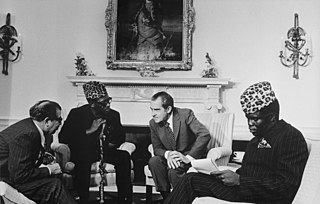
Mobutu Sese Seko's foreign policy emphasized his alliance with the United States and the Western world while supposedly maintaining a non-aligned position in international affairs. Mobutu ruled the Republic of the Congo and then Zaire as president for 32 years, from 1965 to 1997.
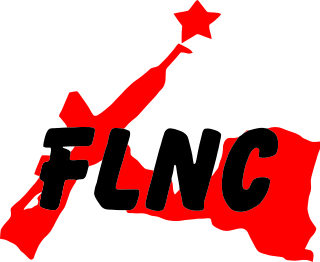
The Congolese National Liberation Front is a political party funded by rebels of Katangese origin and composed of ex-members of the Katangese Gendarmerie. It was active mainly in Angola and Zaire during the 1970s.
The Zaire Use, also called Zairean Rite, officially the Roman Missal for the Dioceses of Zaire, is a Congolese liturgical use of the Roman Rite within the Catholic Church. Approved by the Vatican in 1988, it contains many elements from the Ordinary Form of the Roman Rite, but also incorporates elements from sub-Saharan African culture, particularly Congolese, including a number of inculturated liturgical modifications.
The Baháʼí Faith in the Democratic Republic of the Congo begins after ʻAbdu'l-Bahá wrote letters encouraging taking the religion to Africa in 1916. The first Baháʼí to settle in the country came in 1953 from Uganda. The first Baháʼí Local Spiritual Assembly of the country was elected in 1957. By 1963 there were 143 local assemblies in Congo. Even though the religion was temporarily banned, and the country torn by wars, the religion grew so that in 2003 there were some 541 assemblies. The Association of Religion Data Archives estimated some 290,900 Baháʼís in 2005.
The following lists events that happened during 1987 in the Republic of Zaire.
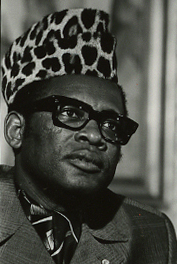
The Constitution of Zaire, was promulgated on 15 August 1974, revised on 15 February 1978, and amended on 5 July 1990. It provided a renewed legal basis for the regime of Mobutu Sese Seko who had emerged as the country's dictator after the Congo Crisis in 1965.

First Lady of the Democratic Republic of the Congo is the title attributed to the wife of the president of the Democratic Republic of the Congo. The country's current first lady is Denise Tshisekedi, wife of President Félix Tshisekedi, who had held the title since January 24, 2019.
The Anglican dioceses of Northern Uganda are the Anglican presence in (roughly) the Northern Region, Uganda; they are part of the Church of Uganda. The remaining dioceses of the Church are in the areas of Buganda, of Eastern Uganda, of Ankole and Kigezi, and of Rwenzori.
The following lists events that happened during 1913 in the Belgian Congo.
The following lists events that happened during 1988 in the Republic of Zaire.
The following lists events that happened during 1989 in the Republic of Zaire.